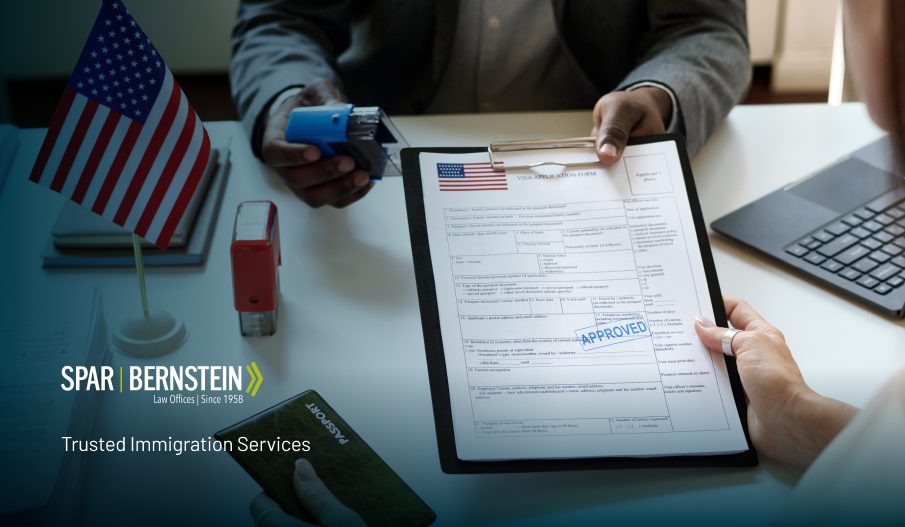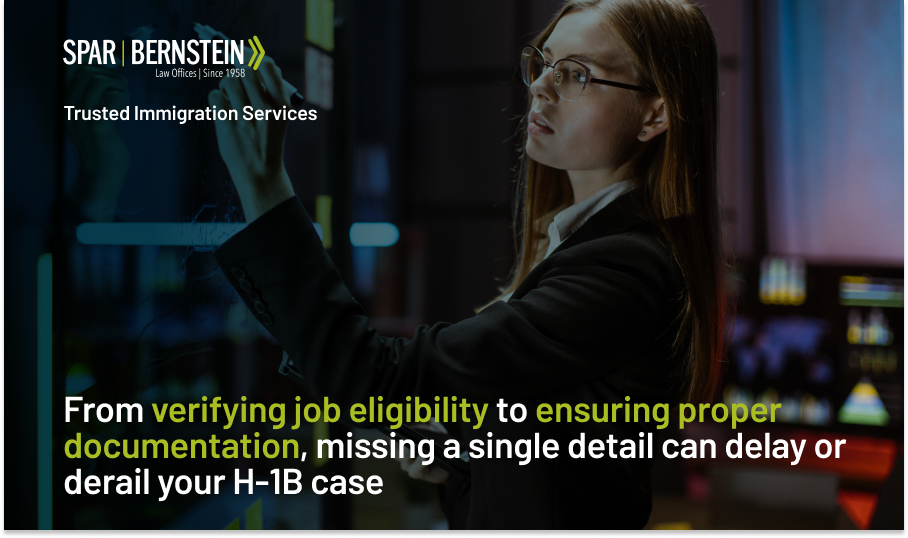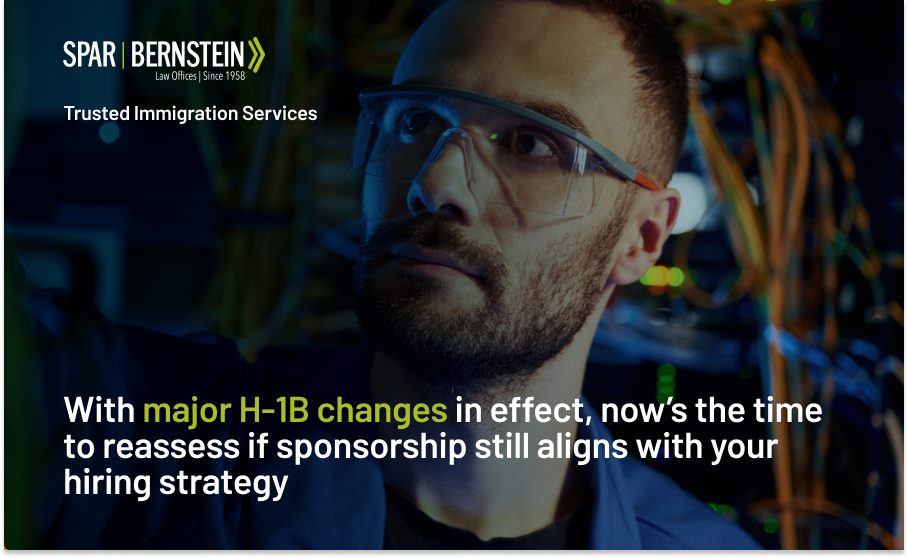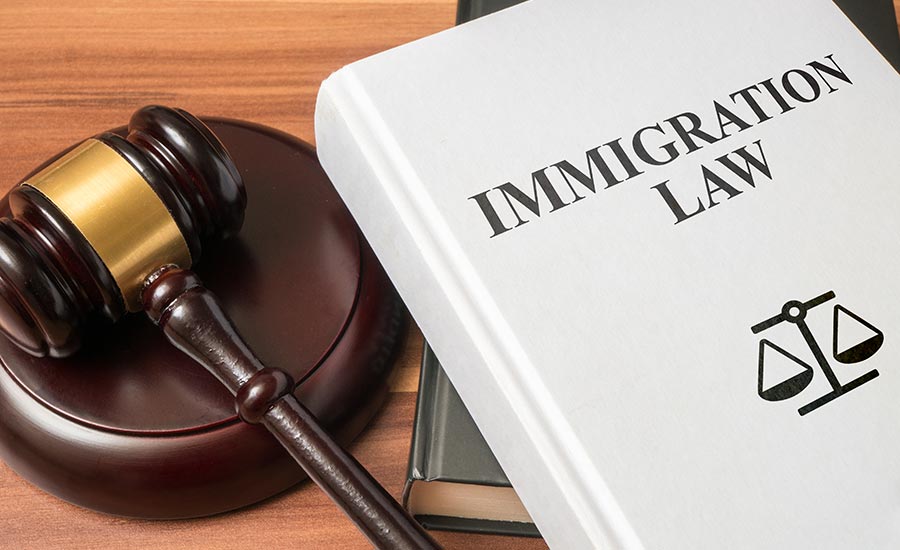

H-1B Visa: Key Takeaways
- You can use the H-1B visa to hire foreign workers in specialty occupations
- To apply for this type of visa, both employers and foreign workers must meet specific criteria, including job eligibility, educational background, prevailing wage compliance, and proper documentation
- The H-1B process includes job and candidate evaluation, filing a Labor Condition Application, submitting Form I-129 to USCIS, and consular processing if the worker is abroad
- A 2025 proclamation by President Trump increases wage standards, tightens compliance, prioritizes high-paid highly skilled professionals, and requires that employers pay a $100,000 filing fee for each foreign worker.
Highly skilled foreign talent can give your business a competitive edge. Many employers have been using this strategy for years.
But things have changed. President Trump has introduced changes to the program that make the H-1B visa more complex than ever.
In this guide, we’ll break down:
- What the H-1B visa is and which roles qualify
- Legal requirements for employers and employees
- Step-by-step details of the application process
- Major 2025 changes impacting filing fees, wage rules, and visa approvals
Understanding The H-1B Visa
The H-1B visa is a nonimmigrant visa that allows U.S. companies to sponsor foreign workers in specialty occupations that require certain expertise.
Common fields where you may use this type of visa include:
- Engineering
- Science
- Education
- IT
- Finance
- Architecture
- Medicine
H-1B Visa Numbers & Annual Limits
There is a cap of 65,000 H-1B visas per fiscal year, plus an additional 20,000 for employees with advanced degrees.
Once the H-1B cap is reached, the U.S. Citizenship and Immigration Services (USCIS) cannot accept or process any H-1B visa petitions for that fiscal year unless they qualify for an exemption.
Exceptions include certain nonprofits and research institutions, which can file petitions year-round.
H-1B Visa Requirements
The success of an H-1B petition requires that both you as the employer and the employee meet clear legal standards.
H-1B Visa Requirements For Employers
To sponsor a worker under the H-1B program, the U.S. employer must meet the following requirements:
- Offer a valid specialty occupation job that requires at least a bachelor’s degree in a specific field.
- Pay at least the prevailing wage for that job in the particular geographic area, as defined by the Department of Labor.
- File Form ETA-9035 with the DOL, confirming working conditions, wage level, and that hiring a foreign worker won’t have a negative impact on U.S. employees.
- Pay the filing fee, which after the H-1B changes of September 2025 has increased to $100,000 per employee.
- Submit Form I-129, Petition for a Nonimmigrant Worker, to USCIS along with supporting documents.
- Ensure ongoing compliance, including accurate records of employment and termination and notifying USCIS of any changes in salary and job responsibilities.
H-1B Visa Requirements For Employees
The worker must show they’re a strong fit for the job. Typically, that means holding a bachelor’s degree or higher in a relevant field. The role must also require that level of education, which is something USCIS will closely review.
How the H-1B Visa Program Works
Sponsoring a foreign worker through the H-1B visa program follows several important steps. Most of them must be completed by you as the employer.
1. Determine Job & Candidate Eligibility
The position you’re offering must qualify as a specialty occupation. This means it should require at least a bachelor’s degree in a specific field like engineering, finance, or IT.
The candidate must hold a U.S. bachelor’s degree or a foreign equivalent in that field. If the degree is from abroad, they may need a credential evaluation.
2. Submit A Labor Condition Application (LCA)
Fill out Form ETA-9035 with the U.S. Department of Labor to certify that you’ll pay the prevailing wage for the position and you’re not displacing a qualified U.S. worker.
Post a job ad and retain documentation in a public access file for compliance purposes.
3. Pay The Filing Fee
Under the 2025 proclamation, if you’re filing an H-1B petition for a worker who is outside the U.S., you are required to pay a $100,000 fee per employee.
If the payment is missing or you don’t show proof that the fee was paid, USCIS will not process your petition.
The only exception is if your worker qualifies for a national interest exemption, which is granted solely at the discretion of the Department of Homeland Security.
4. File The H-1B Petition
Once you’ve completed the LCA, the next step is to package everything, from job details to wage info and the employee’s qualifications, into your H-1B petition and file it, using Form I-129.
5. Wait For USCIS Approval
USCIS will review the petition, request additional evidence if needed, and issue a decision. Typically, processing usually takes months. If you want to speed up the process, you can file Form I-907 to request premium processing and have a decision within 15 days.
After you’ve done these steps, the process shifts to your employee.
If they are already in the U.S. on another visa, they may request a change of status.
If they’re abroad, they’ll need to complete Form DS-160, Online Nonimmigrant Visa Application; go for a visa interview at a U.S. Consulate; and submit biometric data. If successful, they’ll receive an H-1B visa passport stamp and can enter the U.S. to begin work.
However, having your employee in the United States does not put an end to your obligations. You must ensure wages and job duties match the original petition and notify USCIS of any title, location, and salary changes.

Latest Updates On The H-1B Visa
In September 2025, President Trump issued a proclamation with key updates to the H-1B visa process, aiming to protect America’s highly skilled employees.
High Petition Costs For Foreign Talent
As of September 2025, bringing in H-1B talent from overseas comes with a hefty price tag: $100,000 per petition, which is due upfront.
If you don’t provide proof of payment, your petition will not be accepted or processed. This policy will be initially valid for 12 months. It applies to all H-1B workers outside the U.S. unless they qualify for a national interest exemption.
Existing H-1B holders already inside the country are not affected by the change.
Stricter Filing & Compliance Obligations
When submitting your petition, you will need to show you have paid the $100,000 fee. Filing without proof can lead to immediate denials.
Increased Wage Standards
The Department of Labor has been directed to raise prevailing wage levels for H-1B roles. This means you must offer your foreign employees a closer or higher wage for your region, potentially reducing the cost advantage of hiring overseas talent.
Priority For High-Wage, High-Skilled Workers
Going forward, visa processing will favor high-paid, highly skilled professionals, such as Ph.D.s, data scientists, and technical leads, over junior or lower-wage roles.

Need Help With H-1B Visas? Spar & Bernstein Can Help
Sponsoring H-1B workers isn’t as simple as it once was. The fast-changing immigration environment and increased government scrutiny call for legal support that can not only address the new challenges but also predict how these can impact your business.
That’s where the experienced team of Spar & Bernstein comes in.
Our business immigration attorneys will take the pressure off your HR and leadership teams by handling the heavy immigration processes for you.
We will help you determine if a job qualifies as a specialty occupation, evaluate whether the candidate meets USCIS requirements, fill out and file needed documents, and manage changes in compliance so you are protected against fines and reputation damage.
We will also advise on long-term immigration strategies, including H-1B to Green Card transitions
Thinking of hiring a highly skilled employee or scaling a global talent strategy? Call us at 800-529-5465 or fill out our online form and we’ll guide you every step of the way.
H-1B Visa: FAQ
What is the H-1B visa and who can use it?
The H-1B is a nonimmigrant visa that allows you to temporarily hire foreign workers with a bachelor’s degree in specialty occupations.
What happens if I lay off an H-1B worker?
The worker has a 60-day grace period to find a new sponsor, change visa status, or leave the U.S. If the termination occurs before the visa expires, you’ll have to cover the cost of return transportation.
What are my ongoing responsibilities to H-1B visa holders?
As an employer, you must pay the prevailing wage, maintain a public access file (PAF), notify USCIS of changes or terminations, and stay compliant with Department of Labor and USCIS regulations.
How long can an H-1B worker stay in the U.S.?
Initially, a H-1B worker can stay in the U.S. for up to three years, extendable to a maximum of six years. In certain cases, such as when a Green Card process is in progress, extensions beyond six years may be granted.







